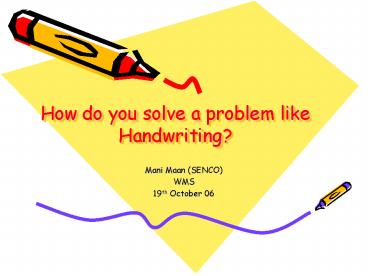How do you solve a problem like Handwriting? - PowerPoint PPT Presentation
1 / 23
Title:
How do you solve a problem like Handwriting?
Description:
Title: How do your solve a problem like Handwriting? Author: J Patel Last modified by: J Patel Created Date: 10/7/2006 5:02:53 PM Document presentation format – PowerPoint PPT presentation
Number of Views:455
Avg rating:3.0/5.0
Title: How do you solve a problem like Handwriting?
1
How do you solve a problem like Handwriting?
- Mani Maan (SENCO)
- WMS
- 19th October 06
2
Introduction
- Explore why a child may be having handwriting
difficulties - Offer helpful strategies
- Handwriting handouts can be used by parents,
teaching staff
3
Developmental stages of handwriting skills
- 1-1½ years- Palmar-supinate grasp
- - scribbles on paper
- - types of scribbles wavy, circular,
vertical, horizontal or combined - - Imitates scribbles
- 2-3 years - Digital-pronate grasp
- - Imitates vertical, horizontal and
circular strokes on paper - - Imitates two or more strokes for a cross
4
Development of handwriting skills
- 3-4 years - Transits to static tripod posture
- - Copies a vertical, horizontal lines and a
circle - - Traces a diamond, but with corners
rounded - - Imitates a cross
- 4-5 years - Static or dynamic tripod grip
- - Copies a cross, right oblique line and
oblique cross - - Copies some letters and numbers
- - May be able to write own name
5
Developmental stages continued
- 5-6 years - Stable dynamic tripod posture
- - copies triangles and diamond
- - Prints own name
- - Copies most lower and upper case letters
- - Begins to form letters with some control
over size, shape and orientation of letters or
lines of writing - 6-7 years - Produce legible upper and lower case
letters in one style and uses them
consistently (that is, not randomly mixed
within words) - - Produces letters that recognisably formed
and properly orientated and that have clear
ascends and descenders where necessary
6
Development stages continued
- 8-10 years -Begins to produce clear and
legible joined up writing - - Produces clear and legible writing in
both printed and cursive styles
Based on Kellogg (1969), Klein (1982), Erhardt
(1982), Department of education and science
(1989),Amundson and Weil (1996)
7
IMPORTANT!!!
If a child is unable to copy / or \, they will be
unable to progress to letter formation (e.g. A,
V, M, X, W
8
ACTIVITY
? ? ? ? ? ? ? ?
9
Normal Handwriting Development - Grasp
10
Pencil Grip
- Difficulties
- Weak grasp
- Tense grasp
- Finger position on pencil shaft (too high or too
low) - Activity time again ?
11
Pencil Grasp Strategies
- Weak grasp
- Short pencil
- Chubby pencils
- Strengthening activities e.g. clothes peg,
theraputty or elastic bands
- Tense grasp
- Pencil grip
- Chubby pencils
- Strengthening activities
- Thicker pencil
- Pencil with leads
12
Pencil Grasp strategies
- Finger positioning on the pencil shaft
- - guide finger placement with a sticker/elastic
band - - pencil grip
13
Pencil Control
- Difficulties
- - Position on the line
- - Left to right/top to bottom
- - Letter/word spacing
- - Letter reversals (after 7 years)
14
Pencil Control Strategies
- Position on the line
- raised line paper
- Three colour lines cues
- Ruler
- Exercise book with coloured lines
- Left to right/Top to bottom
- sticker cues
- Three colour line cues
- Writing in boxes/grid paper
- Sandpaper letters
15
Pencil Control- strategies
- Letter/Word spacing
- - Index finger
- Lollypop stick
- Small stickers
- Little bit of nothing
- Letter reversals
- - After year 4 speak with Educational
Psychologist
16
Hand Dominance- strategies
- Swapping hands
- -Play tabletop games while sitting on
less-dominant hand - Stencils
- Using a ruler
- Opening jars/containers
- Left handedness
- Avoid sitting a left hander on the right side of
a right hander - Position of paper
- Use of left handed scissors
17
Writing strategies
- Practice
- I 0 / \ X
- Multi-sensory approach- sand paper, sand tray,
finger painting - Use different tools ie paint brush, chalk, travel
scribbler
- Design formation e.g.
18
More strategies (younger pupils)
- Colouring within the lines
- Trace around a picture with art glue and let it
dry (forms a ridge) - Use stencils
- Make the background black
19
Scissor Skills
- Difficulties
- - Grip
- Cutting on line
- Use of guiding hand
20
Scissor Skill Strategies
- Use a guiding hand
- Hand over hand assistance
- Practice two handed skills
- Tearing paper and pasting it with glue
- Opening jars and containers
- Action songs (Song practice)
- Ball games
21
Ruler Skills
- Difficulties
- - stabilising while drawing
- Strategies
- Ruler with handle
- Putting dycem on the bottom of the ruler
22
Posture!
- Children need to sit in their chair with their
hips, knees and feet at a 90-degree angle. If the
child's feet do not touch the floor try placing a
box or stool under their feet to help with
stability. - "Stack Their Blocks"
23
Acknowledgements
- Hackney Childrens Occupational Therapy Service
- Northwick Park Hospital Paediatric Occupational
Therapy Service































